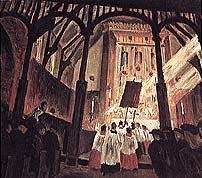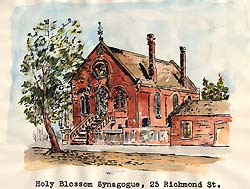|
Natives are immigrants here; several different tribes move peacefully around each other; sometimes quarrels between Hurons and Iroquois are cantankerous and bloody. Some Natives are even slave owners. First People offer remarkable welcome and tolerance to the Europeans - helping them to survive. Natives assist American slaves through the underground railway, and fight alongside the British in the War of 1812.
When the French expand their fur trade, the English follow to establish commerce and government. Desperate for settlers, Lt. Governor Simcoe flings the door open to everyone but the French - a legacy that will inform the Toronto psyche for centuries. Anti-French and anti-Catholic bias will turn against Irish Catholics, Italians and even Louis Riel and his Western rebellions. It is Orange Toronto that howls loudest for his neck in a noose.
For others, Toronto shows necessary tolerance. Fifteen Black men and women are counted in the census of 1799, some of them starting businesses. William Berczy and his German immigrants help Simcoe build Yonge street. Scots found King's College and the Globe newspaper; and it's Scottish immigrant and rebel, William Lyon MacKenzie who becomes Toronto's first mayor in 1834.
 |
|
Easter Processional 1945, by Jack Bush |
The Irish bring their labour and unwanted Catholicism, founding Catholic institutions like Saint Michael's College and the Saint Vincent De Paul Society, which evolves into the Catholic Children's Aid Society. But Catholics chafe against the omnipotence of the Orange Order. Northern Protestant Irish dominate local politics for over a century- their Orange Order produces over 40 Toronto mayors during the next century.
Differences between immigrants are first expressed along
lines of loyalty to the British Crown. English, Scottish and
Orange dominate positions of privilege. Later it is religion
that divides the city. Scottish John
Strachan heads up the dominant Anglicans, while Egerton
Ryerson argues for the Methodists. Orange ascendancy will
push them both aside. But Protestants unite in their shock
at Irish Catholics in the city. Irish Protestants argued bitterly
with their brethren, while Irish Catholics will forge alliances
with Catholic Italians.
It is also immigrants who challenge the politics of privilege. Like 1837 Rebel Leader William Lyon Mackenzie, 20th century immigrants challenge the status quo and make demands on the city. In 1955, Leslie Saunders is the last Orange Mayor, defeated by the first Jewish one, Nathan Phillips. In 1961, Italian construction workers unionize, after ending years of exploitation and unsafe conditions.
It is an easier time for the first English Jews. But poorer Jews from Eastern Europe will wait two generations for acceptance, growing separately in the "Ward" and Kensington market at the turn of the century.
 |
| William Peyton Hubbard |
Chinese laundrymen arrive with the railway to a cold Toronto shoulder. It is William Peyton Hubbard, Toronto's first Black alderman, who defends them against unfair taxes in 1896. More Catholics arrive from Southern Europe - Italians as foreign as the Irish were. Later in the 20th century, Asians, Caribbeans and Africans will dramatically change Toronto.
New immigrants fuel economic growth with their need for houses and goods. They find work in construction and manufacturing. During Toronto's post-Confederation boom, crowds of immigrants and their children work the sweat shops. Eaton's factories are the single biggest employer of Jewish tailors.
It is also immigrants who challenge the politics of privilege. Like Scotsman William Lyon Mackenzie, calling for rebellion in 1837, 20th century immigrants challenge the status quo and make demands on the city. By 1955, Leslie Saunders, the last Orange Mayor is defeated by the first Jewish one, Nathan Phillips. Italian construction workers endure years of William Hubbard exploitation and a terrible construction disaster, until they finally demand better conditions and unions in 1961.
By 1969 half of Toronto's citizens are non-British. Soon the majority will be non-white. The Caribbana Festival, begun in 1966, is Toronto's biggest tourist draw, outperforming the Irish and Orange parades. In the late 1970s, a drastic, irreversible change occurs at the core of Toronto's life. Blacks outnumber Jews, and Chinese are about equal to all East Europeans, compared to the rest of the country, where just over 6% of the population is nonwhite. By 1986 over 40% of the people in Metro are born in another country. One in three residents claims a mother language other than English.
North America's largest ethnic Chinese population lives here, as well as the second largest Greek population outside of Greece. Toronto is home to Canada's largest Jewish community while 650,000 Italians call the place home.
 |
|
Holy Blossom, Toronto's first Synagogue, 1876 |
While the bulk of Canada's immigrants head for Toronto, so do the Canadian born. During the hungry years of the Depression, half of Toronto's homeless are from somewhere else. In the 1970s, 100,000 English Quebecers head west to Toronto down the 401 to get away from the Separatists. Today, almost as many Newfoundlanders live here as on the Rock. Toronto pulls the best and brightest from other parts of the country. No wonder they hate us.
This city's vitality and verve, its very ability to grow
and change has more to do with immigrants than with any other
factor. Seventy thousand newcomers arrive in Toronto every
year, speaking over 100 different languages.
Next: Social Justice and Human Rights
| 